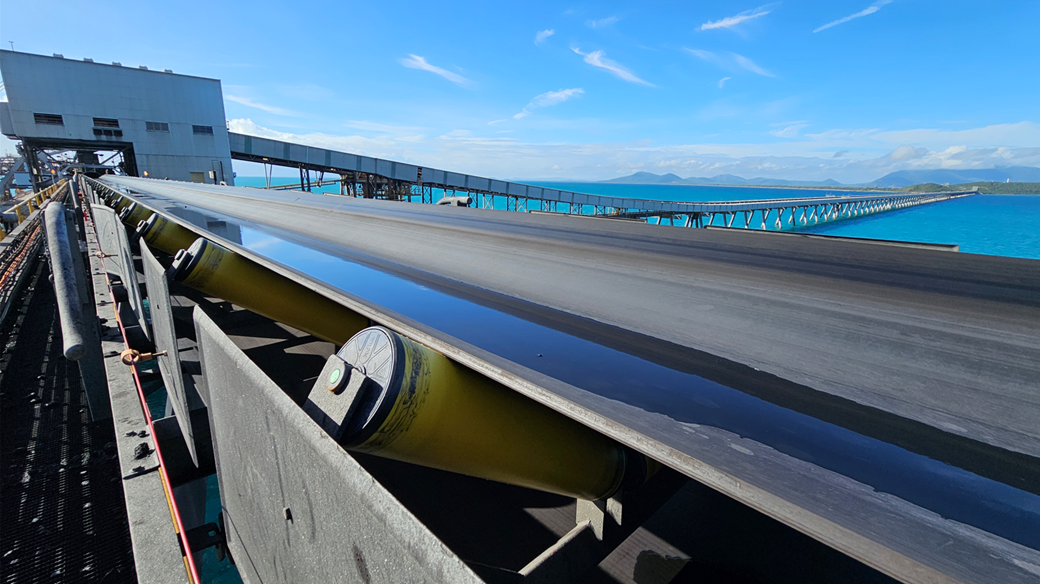
Belt drift happens on every mine site, and some movement is normal. But when belts start damaging structures, spilling material or fraying at the edges, minor tracking issues can quickly become costly.
For maintenance superintendents, the challenge lies in identifying the root cause. Is carryback shifting the load off-centre? Are rollers out of alignment? Is there uneven tension? These problems aren’t always obvious — especially when crews are under pressure to get conveyors back online fast.
If you’re battling mistracking issues, these six areas are worth a closer look. Addressing them can help extend belt life, prevent downtime and ensure maintenance teams tackle the real cause — not just the symptoms.
- Misaligned components after maintenance work
During installation, idler frames and pulleys are aligned precisely, but ground movement and rushed maintenance can throw this balance off.
“When you replace a pulley or an idler frame and eyeball it, those slight errors stack up and lead to tracking issues,” says Elvin Sey, Mechanical Engineer at PROK. Even a few millimetres of offset can cause cumulative misalignment.
When the belt enters a pulley on an angle, it exits on an angle — compounding with every rotation. You may not notice until wear or spillage appears.
What to check:
• Idler frame squareness during replacements
• Pulley alignment using survey or laser tools
• Structural drift over time
- Seized or misaligned rollers
Seized rollers are a common but serious source of tracking problems. When a roller stops turning, the belt drags across it, generating heat and tension imbalance that causes drift toward the seized side.
“A seized roller acts like a brake,” Elvin explains. “It can pull the belt to one side, especially on fabric belts 1000mm or less.” Even slightly misaligned rollers can lift one belt edge, creating localised tension and edge wear.
Use high-quality rollers with robust sealing, balanced shell design and durable construction. Inferior rollers can fail up to six times sooner.
What to check:
• Seized or dragging rollers (thermal imaging helps)
• Uneven roller heights or gaps
• Roller condition in wet areas
- Off-centre material loading
Even a perfectly aligned belt will track poorly if material isn’t loaded evenly.
“If material is loaded to the left, the centre of mass pulls the belt down to the right,” says Elvin. Over time, consistent off-centre loading shifts the belt in that direction.
Chute misalignment, worn feed points or uncontrolled flow can all cause this. Persuaders — static frames with guide rollers — can provide temporary stability.
“Ideally, install persuaders coming into the tail pulley, just before and after the loading zone,” says Elvin. “Sometimes more than one is needed to stabilise the belt and prevent edge damage.”
What to check:
• Evenness of material entry at the chute
• Variations in feed rate, density or moisture
• Shifts in chute or skirt alignment
- High-tension zones that amplify minor issues
Belt tension isn’t consistent along a conveyor. High-tension areas, such as near the head pulley or take-up, behave differently from low-tension sections.
“In these zones, the belt is more rigid — that’s where structure or belt edge damage often starts,” Elvin explains. Precise alignment is critical, as the belt is less forgiving.
Persuaders can offer short-term protection here, but realignment or repairs are essential for lasting results.
What to check:
• Alignment in high-tension sections
• Structural rigidity around head and take-up pulleys
• Concentrated edge wear or fraying
- Belt splices that alter tracking lines
Splice geometry and quality affect tracking more than many realise. Any offset, thickness variation or stiffness change can shift how the belt runs.
“Splices can introduce tracking issues if they aren’t done well,” says Elvin. Even small inconsistencies can make the belt ‘hunt’, moving side to side and causing uneven wear.
Splice-related mistracking is often subtle, appearing weeks later when wear patterns emerge.
What to check:
• Splice alignment and geometry
• Wear on skirts or rollers near splices
• Tension consistency before and after the splice
- Over-reliance on trainer frames
Trainer frames can help, but relying on them too heavily is a short-term fix. Without identifying the cause, the problem persists.
“On some mines we’ve seen up to ten trainer frames in a row. It’s a band-aid, not a long-term solution,” Elvin says. Trainer frames work best on the return side where the belt is unloaded. Placing them near pulleys or in high-tension zones can worsen tracking.
Each additional trainer frame without proper diagnosis delays a real solution — and adds cost.
What to check:
• Placement in low-tension zones
• Distance from pulleys for optimal correction
• Whether issues persist despite multiple frames
Find the root cause for long-term reliability
Trainer frames and persuaders can keep production moving, but they won’t fix the underlying cause. Identifying the real issue takes time, data and collaboration.
“We’ve seen six-year belts that had to be replaced after only two,” Elvin says. “That’s millions lost.”
For maintenance managers, the key is knowing when to apply a temporary fix and when to dig deeper. Balancing short-term needs with long-term reliability can mean the difference between a belt that lasts its design life — and one that fails early, taking productivity and profit with it.

